Easy care hanging house plants are a fantastic way to add a touch of greenery and freshness to your home without the hassle of constant upkeep. From low-maintenance varieties to those that thrive in various light conditions, there’s a hanging plant to suit every space and lifestyle.
Hanging plants not only beautify your home but also improve air quality and create a sense of tranquility. With proper care, these plants can thrive for years, bringing joy and vitality to your living space.
Low-Maintenance Hanging Plants
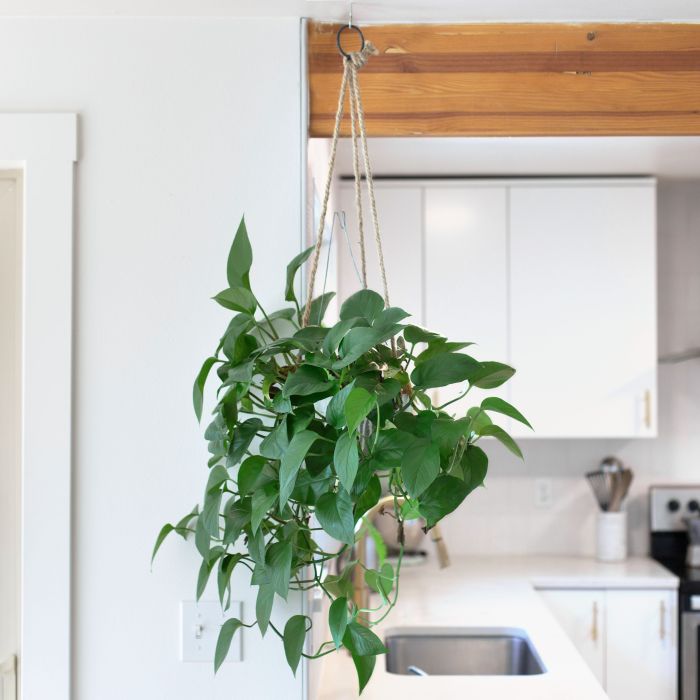
Hanging plants bring a touch of greenery and life to any space, but they can also be a chore to care for. If you’re looking for low-maintenance hanging plants that will thrive with minimal attention, here are a few options to consider:
Easy-Care Hanging Plants
- Spider plant (Chlorophytum comosum):Spider plants are known for their long, trailing leaves and easy-to-care-for nature. They can tolerate a wide range of light conditions and infrequent watering.
- Pothos (Epipremnum aureum):Pothos is another popular choice for hanging baskets. It has heart-shaped leaves that come in a variety of colors, and it can tolerate low light and infrequent watering.
- ZZ plant (Zamioculcas zamiifolia):ZZ plants are known for their drought tolerance and ability to thrive in low light. They have glossy, dark green leaves that add a touch of elegance to any space.
- String of pearls (Senecio rowleyanus):String of pearls is a unique and eye-catching hanging plant with long, trailing stems that resemble strings of pearls. It prefers bright, indirect light and infrequent watering.
- Air plants (Tillandsia spp.):Air plants are a great choice for those who want to add some greenery to their space without having to worry about soil or watering. They absorb moisture from the air and can be displayed in a variety of ways.
Hanging Plants for Different Light Conditions
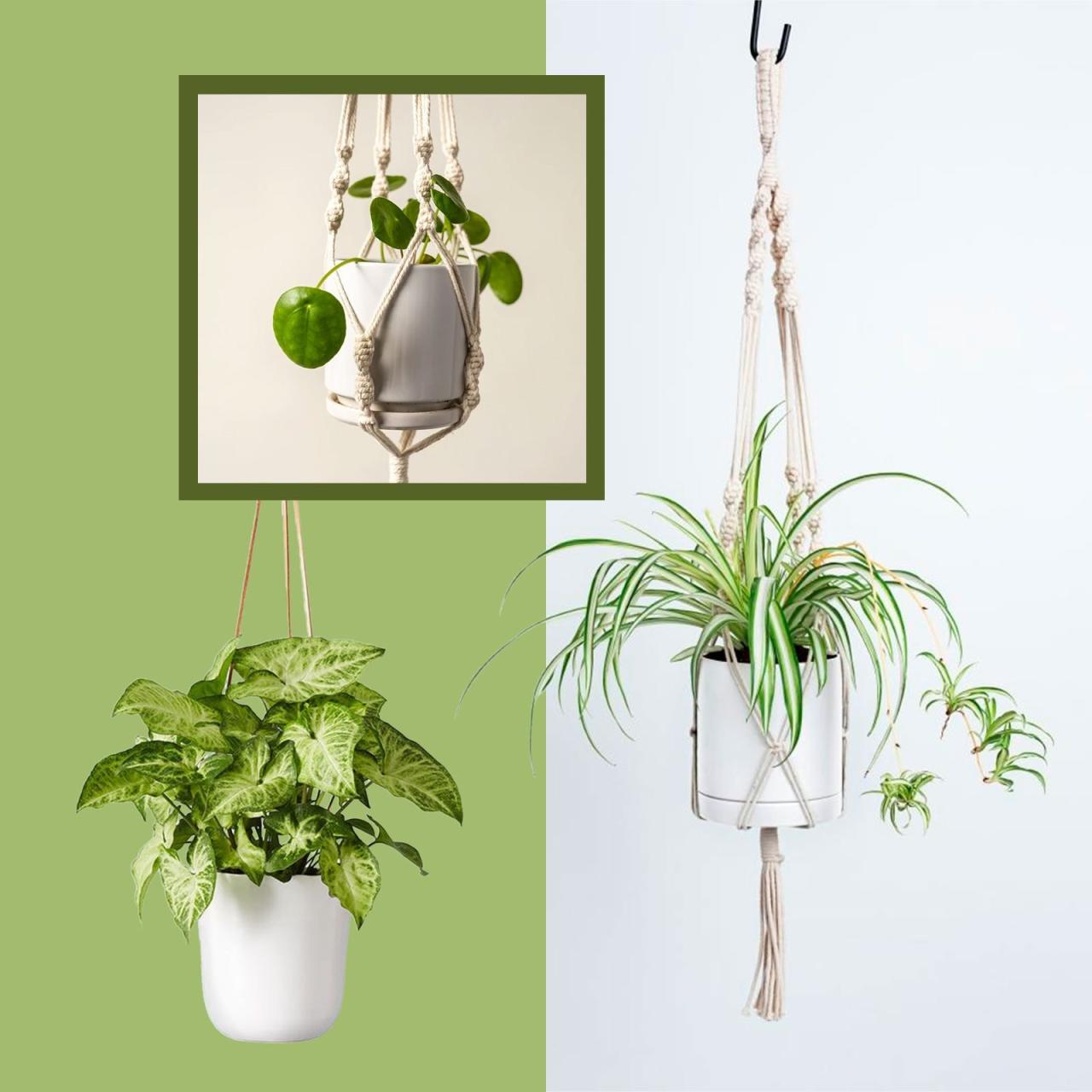
The amount of light a hanging plant receives can significantly impact its growth and overall health. Different plants have varying light requirements, and choosing the right ones for your specific light conditions is crucial for their success.
Low Light Conditions
For areas with low light, such as north-facing windows or dimly lit rooms, consider plants that can tolerate shade. These include:
- Snake plant ( Sansevieria trifasciata): Known for its hardiness and ability to thrive in low light conditions.
- ZZ plant ( Zamioculcas zamiifolia): A low-maintenance plant that can tolerate both low light and infrequent watering.
- Cast iron plant ( Aspidistra elatior): A classic choice for low light areas, known for its dark green, glossy leaves.
Medium Light Conditions
For areas with moderate light, such as east- or west-facing windows, choose plants that prefer indirect or filtered light. These include:
- Pothos ( Epipremnum aureum): A versatile plant with trailing vines and heart-shaped leaves that can tolerate varying light levels.
- Spider plant ( Chlorophytum comosum): A fast-growing plant that produces long, slender leaves and baby plants (spiderettes) at the ends of its stems.
- Peace lily ( Spathiphyllum wallisii): A graceful plant with dark green leaves and white, spathe-like flowers that prefer indirect light.
Bright Light Conditions
For areas with abundant light, such as south-facing windows or rooms with lots of natural light, select plants that can withstand direct sunlight. These include:
- String of pearls ( Senecio rowleyanus): A unique plant with trailing stems adorned with spherical, pearl-like leaves.
- Hoya ( Hoya carnosa): A flowering plant with thick, waxy leaves and clusters of fragrant blooms.
- Jade plant ( Crassula ovata): A succulent with thick, fleshy leaves and a compact growth habit.
Tips for Maintaining Healthy Hanging Plants
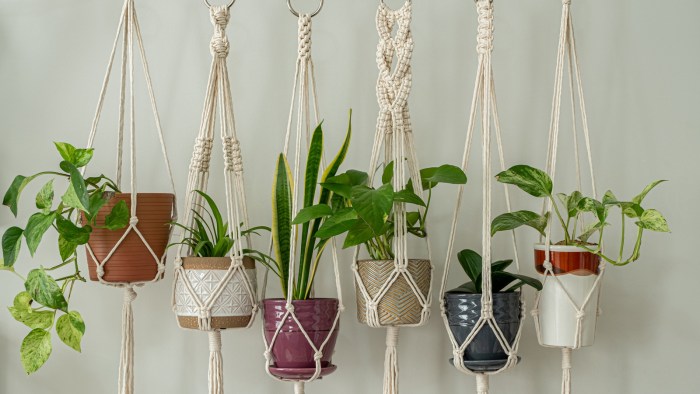
Maintaining healthy hanging plants requires attention to specific care practices. This includes understanding their watering, fertilizing, and pruning needs, as well as avoiding common problems like overwatering and pests.
Watering
Hanging plants require regular watering, but the frequency depends on factors such as plant species, pot size, and the surrounding environment. It’s important to avoid overwatering, as this can lead to root rot. To check if a plant needs watering, insert a finger into the soil; if it feels dry up to the first knuckle, it’s time to water.
Easy-care hanging house plants can add a touch of greenery and freshness to your home. To enhance their visual appeal and create a unique indoor ambiance, consider incorporating DIY wall planters. Check out our guide to 5 DIY Indoor Wall Planters to Bring Life to Your Walls . These creative planters will showcase your hanging plants beautifully, adding a touch of nature to your walls while complementing your easy-care indoor garden.
Fertilizing
Fertilizing hanging plants every two to four weeks during the growing season is recommended. Use a balanced liquid fertilizer diluted to half strength. Avoid over-fertilizing, as this can burn the plant’s roots.
Pruning
Pruning hanging plants helps maintain their shape and encourage new growth. Remove dead or yellowed leaves and stems as needed. For trailing plants, trim back long vines to prevent them from becoming tangled or leggy.
Avoiding Overwatering
Overwatering is a common problem for hanging plants. Ensure the pot has drainage holes to prevent water from accumulating at the bottom. Water the plant only when the soil feels dry to the touch. If the plant’s leaves turn yellow or brown and fall off, it may be a sign of overwatering.
With minimal care, hanging house plants can bring lush greenery to your space. For those seeking low-light options, 5 Draping Indoor Plants for Low Light: Beautify Your Space with Minimal Effort provides expert insights on the best choices. These trailing plants require minimal upkeep and thrive in shaded areas, making them ideal for busy individuals or those with limited natural light.
Preventing Pests
Hanging plants can be susceptible to pests such as aphids, mealybugs, and spider mites. Regularly inspect plants for signs of infestation. If pests are found, isolate the affected plant and treat it with an appropriate pesticide.By following these tips, you can maintain healthy and vibrant hanging plants that will add beauty and freshness to your indoor space.
Easy care hanging house plants are a great way to add life and greenery to your home. For those with busy schedules or limited gardening experience, there are many low-maintenance options available. From trailing vines like pothos and spider plants to lush ferns and air plants, there’s a wide selection to choose from.
If you’re looking for inspiration, Hanging Plants Indoor offers a comprehensive guide to help you find the perfect hanging plants for your space. With proper care and attention, these easy-to-grow plants can thrive indoors, bringing a touch of nature and beauty to your home.
Designing with Hanging Plants: Easy Care Hanging House Plants

Incorporating hanging plants into interior design adds a touch of greenery and freshness to any space. Not only do they enhance the aesthetics, but they also improve air quality by removing toxins and increasing humidity.
When designing with hanging plants, consider the size and shape of the space, as well as the amount of natural light available. For small spaces, opt for smaller plants that won’t overwhelm the area. In larger spaces, you can choose larger plants or create a cluster of smaller ones.
Creating Visual Interest, Easy care hanging house plants
- Hang plants at different heights to create a dynamic look.
- Use plants with varying textures and colors to add visual appeal.
- Hang plants in groups to create a focal point or to define a specific area.
Improving Air Quality
- Choose plants known for their air-purifying abilities, such as spider plants, peace lilies, and ferns.
- Place plants near windows or other areas with good air circulation.
- Mist plants regularly to increase humidity and remove toxins.
Unique and Eye-Catching Hanging Plants
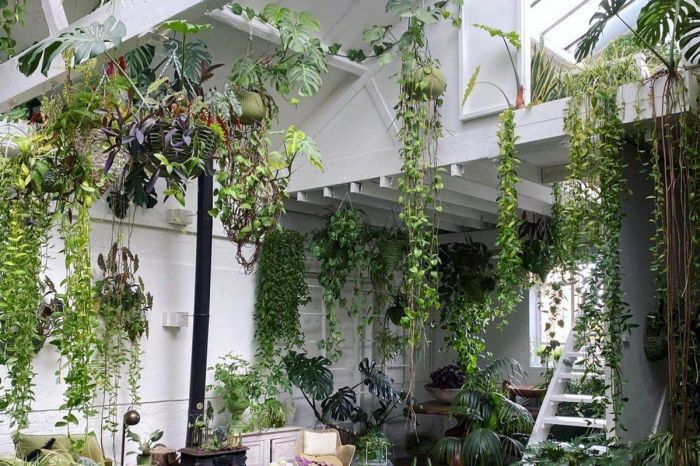
Hanging plants add a touch of greenery and visual interest to any space, and there are many unique and eye-catching options to choose from. These plants offer a variety of textures, colors, and shapes, making them perfect for adding a touch of personality to your home.Some
For effortless elegance, consider incorporating easy-care hanging house plants into your indoor decor. Explore a range of verdant beauties that cascade effortlessly, adding a touch of nature to any room. Discover the 5 Drape Plants for a Lush Indoor Oasis and elevate your living space with lush, trailing greenery that requires minimal upkeep.
of the most unique hanging plants include:
- String of Pearls (Senecio rowleyanus):This plant has long, trailing stems that are covered in small, bead-like leaves. It is a low-maintenance plant that is easy to care for, and it can be grown in a variety of light conditions.
- Air Plants (Tillandsia spp.):These plants do not need soil to grow, and they absorb moisture and nutrients from the air. They are a great choice for people who do not have a lot of time to care for plants, and they can be displayed in a variety of ways, such as in terrariums or on driftwood.
- Staghorn Fern (Platycerium spp.):This fern has large, shield-shaped fronds that are covered in brown scales. It is a slow-growing plant that can live for many years, and it is a great choice for adding a touch of drama to your home.
When choosing a unique hanging plant, it is important to consider the amount of light your space receives and the amount of care you are willing to give. With so many different options to choose from, you are sure to find the perfect plant to add a touch of personality to your home.
Final Review
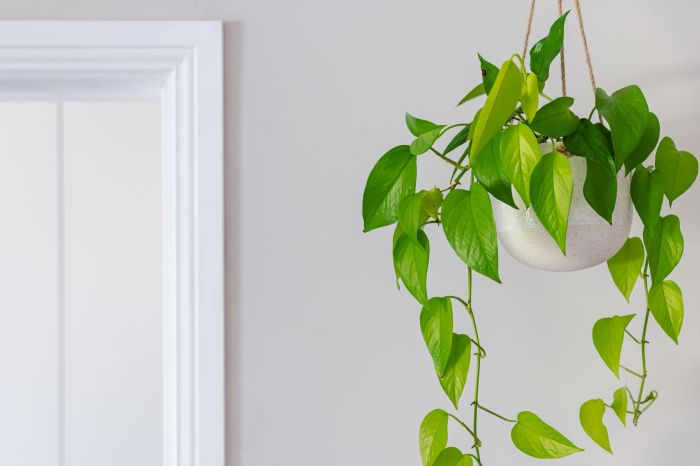
Incorporating easy care hanging house plants into your home is a rewarding experience that offers both aesthetic and practical benefits. Whether you’re a seasoned plant enthusiast or a novice gardener, these plants provide a hassle-free way to enjoy the beauty of nature indoors.
Quick FAQs
How often should I water my hanging plants?
Watering frequency depends on the plant species, but a general rule is to water when the top inch of soil feels dry to the touch.
What is the best way to fertilize hanging plants?
Use a balanced liquid fertilizer diluted to half strength and apply it during the growing season (spring and summer).
How can I prevent pests from damaging my hanging plants?
Regularly inspect your plants for pests and treat them promptly with an appropriate insecticide. Maintaining good plant hygiene and avoiding overwatering can also help prevent infestations.